Analysis of Primary Health Care Concepts in New Zealand Context
VerifiedAdded on 2023/06/06
|11
|2959
|199
Essay
AI Summary
This essay delves into the primary healthcare concepts in New Zealand, analyzing the nation's progress in achieving the ideals of the Alma-Ata and Ottawa Charter declarations. It examines the crucial elements of accessibility, community participation, and inequity within the context of the NZ healthcare system. The essay explores the challenges of accessibility, including geographical barriers and the tension between government responsibility and private GP practices. It also addresses the importance of community involvement, highlighting the need for consumer input and a balance between business models and humanitarian needs. Furthermore, it investigates health inequities, particularly for Maori and Pacific populations, and discusses the impact of historical and cultural factors. The essay concludes by emphasizing the significance of accessible, high-quality healthcare for promoting health equity and the ongoing efforts to align New Zealand's healthcare policies with the Alma-Ata principles, ultimately aiming for improved health outcomes for all citizens.
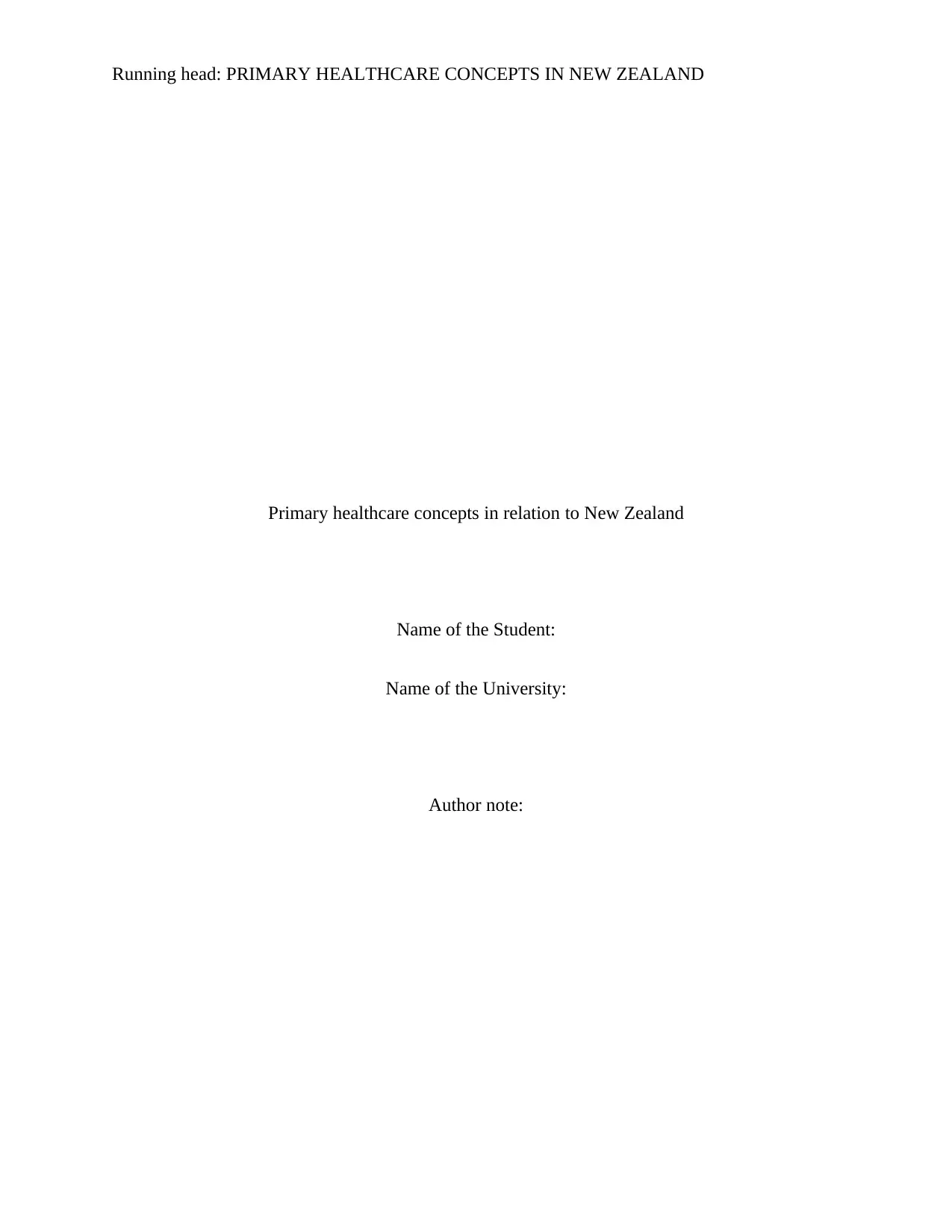
Running head: PRIMARY HEALTHCARE CONCEPTS IN NEW ZEALAND
Primary healthcare concepts in relation to New Zealand
Name of the Student:
Name of the University:
Author note:
Primary healthcare concepts in relation to New Zealand
Name of the Student:
Name of the University:
Author note:
Paraphrase This Document
Need a fresh take? Get an instant paraphrase of this document with our AI Paraphraser

1
PRIMARY HEALTHCARE CONCEPTS IN NEW ZEALAND
Primary Health Care Concepts
In an ideal world accessibility of health care would be achievable. However, that ideal
world does not yet exist. In September 1978 in Alma-Ata USSR countries joined together to
discuss this very topic. On item V of the Alma-Ata it states, “Governments have a responsibility
for the health of their people which can be fulfilled only by the provision of adequate health and
social measures…” The target date for that was year 2000 and at the writing of this essay we are
now 18-years past that target date. On a global level the ideals of the Alma-Ata and the Ottawa
Charter have not been achieved (WHO, 1978). For individual countries such as New Zealand
who signed the agreements have the steps been taken to positively achieve enough of the ideals
contained in these documents? This essay will explore the primary health care concepts of
accessibility, community participation and inequity to explore what has been achieved and what
still needs to be achieved in New Zealand. The declarations of the Alma-Ata and later the Ottawa
Charter were in agreement regarding the value of Primary Health Care.
Accessibility
Accessibility to health care services needs to be refined so that emphasis of the care planning and
implementation is on providing equal and equitable access to each and every one in need of
health care services.
The reverting back to taking health care into the homes and work places of the
community is paramount to increasing the quality of health and outcomes for people. In the 70s
and 80s the push was to centralize everything and to make the hospital the centre for all medical
treatments. This soon became a very inefficient system and creating back logs and waiting lists
that frustrated patients and made them await too long for their treatments. For those who could
PRIMARY HEALTHCARE CONCEPTS IN NEW ZEALAND
Primary Health Care Concepts
In an ideal world accessibility of health care would be achievable. However, that ideal
world does not yet exist. In September 1978 in Alma-Ata USSR countries joined together to
discuss this very topic. On item V of the Alma-Ata it states, “Governments have a responsibility
for the health of their people which can be fulfilled only by the provision of adequate health and
social measures…” The target date for that was year 2000 and at the writing of this essay we are
now 18-years past that target date. On a global level the ideals of the Alma-Ata and the Ottawa
Charter have not been achieved (WHO, 1978). For individual countries such as New Zealand
who signed the agreements have the steps been taken to positively achieve enough of the ideals
contained in these documents? This essay will explore the primary health care concepts of
accessibility, community participation and inequity to explore what has been achieved and what
still needs to be achieved in New Zealand. The declarations of the Alma-Ata and later the Ottawa
Charter were in agreement regarding the value of Primary Health Care.
Accessibility
Accessibility to health care services needs to be refined so that emphasis of the care planning and
implementation is on providing equal and equitable access to each and every one in need of
health care services.
The reverting back to taking health care into the homes and work places of the
community is paramount to increasing the quality of health and outcomes for people. In the 70s
and 80s the push was to centralize everything and to make the hospital the centre for all medical
treatments. This soon became a very inefficient system and creating back logs and waiting lists
that frustrated patients and made them await too long for their treatments. For those who could
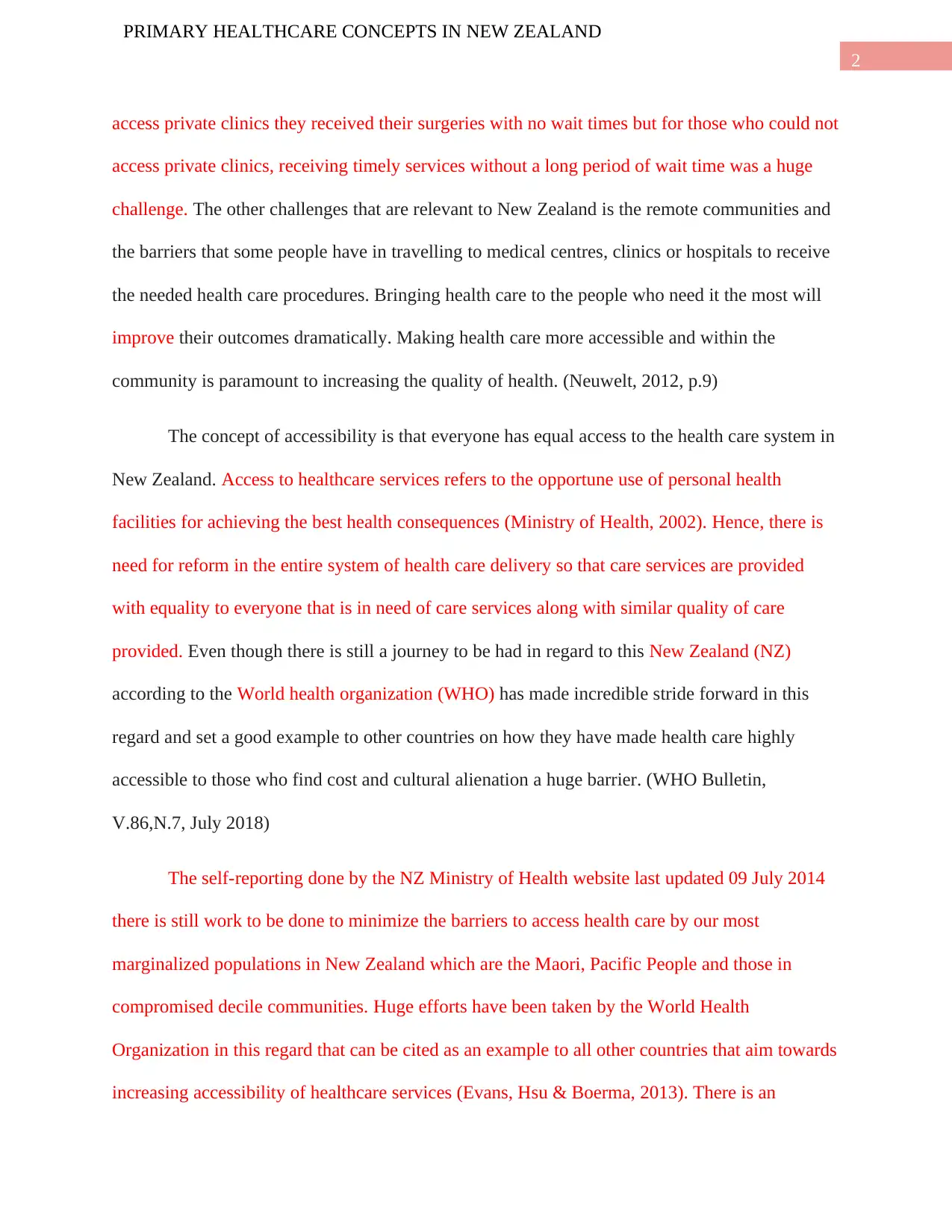
2
PRIMARY HEALTHCARE CONCEPTS IN NEW ZEALAND
access private clinics they received their surgeries with no wait times but for those who could not
access private clinics, receiving timely services without a long period of wait time was a huge
challenge. The other challenges that are relevant to New Zealand is the remote communities and
the barriers that some people have in travelling to medical centres, clinics or hospitals to receive
the needed health care procedures. Bringing health care to the people who need it the most will
improve their outcomes dramatically. Making health care more accessible and within the
community is paramount to increasing the quality of health. (Neuwelt, 2012, p.9)
The concept of accessibility is that everyone has equal access to the health care system in
New Zealand. Access to healthcare services refers to the opportune use of personal health
facilities for achieving the best health consequences (Ministry of Health, 2002). Hence, there is
need for reform in the entire system of health care delivery so that care services are provided
with equality to everyone that is in need of care services along with similar quality of care
provided. Even though there is still a journey to be had in regard to this New Zealand (NZ)
according to the World health organization (WHO) has made incredible stride forward in this
regard and set a good example to other countries on how they have made health care highly
accessible to those who find cost and cultural alienation a huge barrier. (WHO Bulletin,
V.86,N.7, July 2018)
The self-reporting done by the NZ Ministry of Health website last updated 09 July 2014
there is still work to be done to minimize the barriers to access health care by our most
marginalized populations in New Zealand which are the Maori, Pacific People and those in
compromised decile communities. Huge efforts have been taken by the World Health
Organization in this regard that can be cited as an example to all other countries that aim towards
increasing accessibility of healthcare services (Evans, Hsu & Boerma, 2013). There is an
PRIMARY HEALTHCARE CONCEPTS IN NEW ZEALAND
access private clinics they received their surgeries with no wait times but for those who could not
access private clinics, receiving timely services without a long period of wait time was a huge
challenge. The other challenges that are relevant to New Zealand is the remote communities and
the barriers that some people have in travelling to medical centres, clinics or hospitals to receive
the needed health care procedures. Bringing health care to the people who need it the most will
improve their outcomes dramatically. Making health care more accessible and within the
community is paramount to increasing the quality of health. (Neuwelt, 2012, p.9)
The concept of accessibility is that everyone has equal access to the health care system in
New Zealand. Access to healthcare services refers to the opportune use of personal health
facilities for achieving the best health consequences (Ministry of Health, 2002). Hence, there is
need for reform in the entire system of health care delivery so that care services are provided
with equality to everyone that is in need of care services along with similar quality of care
provided. Even though there is still a journey to be had in regard to this New Zealand (NZ)
according to the World health organization (WHO) has made incredible stride forward in this
regard and set a good example to other countries on how they have made health care highly
accessible to those who find cost and cultural alienation a huge barrier. (WHO Bulletin,
V.86,N.7, July 2018)
The self-reporting done by the NZ Ministry of Health website last updated 09 July 2014
there is still work to be done to minimize the barriers to access health care by our most
marginalized populations in New Zealand which are the Maori, Pacific People and those in
compromised decile communities. Huge efforts have been taken by the World Health
Organization in this regard that can be cited as an example to all other countries that aim towards
increasing accessibility of healthcare services (Evans, Hsu & Boerma, 2013). There is an
⊘ This is a preview!⊘
Do you want full access?
Subscribe today to unlock all pages.

Trusted by 1+ million students worldwide
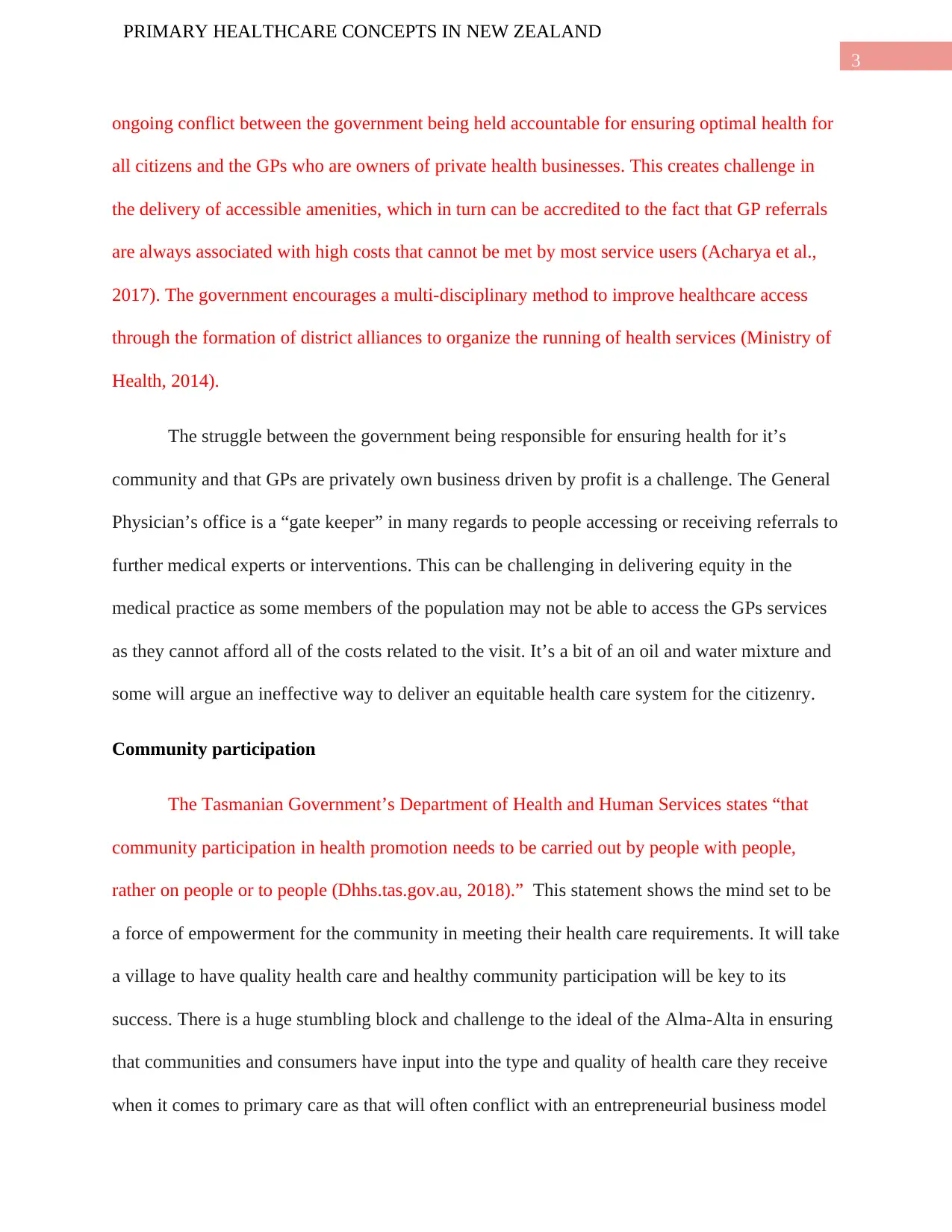
3
PRIMARY HEALTHCARE CONCEPTS IN NEW ZEALAND
ongoing conflict between the government being held accountable for ensuring optimal health for
all citizens and the GPs who are owners of private health businesses. This creates challenge in
the delivery of accessible amenities, which in turn can be accredited to the fact that GP referrals
are always associated with high costs that cannot be met by most service users (Acharya et al.,
2017). The government encourages a multi-disciplinary method to improve healthcare access
through the formation of district alliances to organize the running of health services (Ministry of
Health, 2014).
The struggle between the government being responsible for ensuring health for it’s
community and that GPs are privately own business driven by profit is a challenge. The General
Physician’s office is a “gate keeper” in many regards to people accessing or receiving referrals to
further medical experts or interventions. This can be challenging in delivering equity in the
medical practice as some members of the population may not be able to access the GPs services
as they cannot afford all of the costs related to the visit. It’s a bit of an oil and water mixture and
some will argue an ineffective way to deliver an equitable health care system for the citizenry.
Community participation
The Tasmanian Government’s Department of Health and Human Services states “that
community participation in health promotion needs to be carried out by people with people,
rather on people or to people (Dhhs.tas.gov.au, 2018).” This statement shows the mind set to be
a force of empowerment for the community in meeting their health care requirements. It will take
a village to have quality health care and healthy community participation will be key to its
success. There is a huge stumbling block and challenge to the ideal of the Alma-Alta in ensuring
that communities and consumers have input into the type and quality of health care they receive
when it comes to primary care as that will often conflict with an entrepreneurial business model
PRIMARY HEALTHCARE CONCEPTS IN NEW ZEALAND
ongoing conflict between the government being held accountable for ensuring optimal health for
all citizens and the GPs who are owners of private health businesses. This creates challenge in
the delivery of accessible amenities, which in turn can be accredited to the fact that GP referrals
are always associated with high costs that cannot be met by most service users (Acharya et al.,
2017). The government encourages a multi-disciplinary method to improve healthcare access
through the formation of district alliances to organize the running of health services (Ministry of
Health, 2014).
The struggle between the government being responsible for ensuring health for it’s
community and that GPs are privately own business driven by profit is a challenge. The General
Physician’s office is a “gate keeper” in many regards to people accessing or receiving referrals to
further medical experts or interventions. This can be challenging in delivering equity in the
medical practice as some members of the population may not be able to access the GPs services
as they cannot afford all of the costs related to the visit. It’s a bit of an oil and water mixture and
some will argue an ineffective way to deliver an equitable health care system for the citizenry.
Community participation
The Tasmanian Government’s Department of Health and Human Services states “that
community participation in health promotion needs to be carried out by people with people,
rather on people or to people (Dhhs.tas.gov.au, 2018).” This statement shows the mind set to be
a force of empowerment for the community in meeting their health care requirements. It will take
a village to have quality health care and healthy community participation will be key to its
success. There is a huge stumbling block and challenge to the ideal of the Alma-Alta in ensuring
that communities and consumers have input into the type and quality of health care they receive
when it comes to primary care as that will often conflict with an entrepreneurial business model
Paraphrase This Document
Need a fresh take? Get an instant paraphrase of this document with our AI Paraphraser

4
PRIMARY HEALTHCARE CONCEPTS IN NEW ZEALAND
and its management of the business of private GP practices in medical centres. There is a need to
find balance between profit and the humanitarian need to provide essential health care services.
(Neuwelt, et al., 2005, p. 6)
Inequity
In a report published in September 2002 by the Ministry of Health titled Reducing
Inequalities in Health Care, the leading issues in inequity in the current health care situation has
been highlighted. These can include not just health but economical, cultural, geographical and
social barriers to name just a few. Health inequities refer to systematic variances that exist in the
health consequences or dissemination of healthcare resources amid various population groups.
These inequities usually originate from a plethora of social conditions where the people take
birth, live, grow, work, and die. The health inequities are typically unfair and can be effectively
addressed through the implementation of several government legislation and policies. The
inequity is systemic through New Zealand and is a huge issue to tackle. New Zealand has many
good intentions and policies in place to sincerely act and implement the Alma-Ata and Ottawa
Charters declarations on public health care and even with all of the resources, policies and
practices in place are still not there yet with meeting them yet.
Author Raeburn Lange (1999) in his book May the People Live: A History of Maori
Health Development 1900-1920 talks extensively about how Maori people were once thought of
as the “dying race” only began to increase in numbers when Maori took leadership and took
charge of their own health outcomes. Once thought to be going extinct in the early 1900s now
Maori populations are flourishing (Nicolson, 2017). This calls for the need of addressing the
health preferences and demands of the community by recognizing their values, in addition to
PRIMARY HEALTHCARE CONCEPTS IN NEW ZEALAND
and its management of the business of private GP practices in medical centres. There is a need to
find balance between profit and the humanitarian need to provide essential health care services.
(Neuwelt, et al., 2005, p. 6)
Inequity
In a report published in September 2002 by the Ministry of Health titled Reducing
Inequalities in Health Care, the leading issues in inequity in the current health care situation has
been highlighted. These can include not just health but economical, cultural, geographical and
social barriers to name just a few. Health inequities refer to systematic variances that exist in the
health consequences or dissemination of healthcare resources amid various population groups.
These inequities usually originate from a plethora of social conditions where the people take
birth, live, grow, work, and die. The health inequities are typically unfair and can be effectively
addressed through the implementation of several government legislation and policies. The
inequity is systemic through New Zealand and is a huge issue to tackle. New Zealand has many
good intentions and policies in place to sincerely act and implement the Alma-Ata and Ottawa
Charters declarations on public health care and even with all of the resources, policies and
practices in place are still not there yet with meeting them yet.
Author Raeburn Lange (1999) in his book May the People Live: A History of Maori
Health Development 1900-1920 talks extensively about how Maori people were once thought of
as the “dying race” only began to increase in numbers when Maori took leadership and took
charge of their own health outcomes. Once thought to be going extinct in the early 1900s now
Maori populations are flourishing (Nicolson, 2017). This calls for the need of addressing the
health preferences and demands of the community by recognizing their values, in addition to

5
PRIMARY HEALTHCARE CONCEPTS IN NEW ZEALAND
building separate hospitals and medical centres for them that encompasses their culture, science,
and spiritual needs.
Alma Mata and how it influences the Private Health Care Concepts:
The Alma-Ata though a document from 1978 has significant relevance even today in
2018 even though it is 18-years post its target date for achieving its ideals. It recognizes that
Health is not simply an absence of disease but a fundamental human right. It recognizes the
political, social and economic barriers in both developed and developing countries in accessing
their health care needs (WHO, 1978). The statement of empowering people with the right and
duty to be involved in the planning and implementing their health care plans is still something
that is becoming more and more applicable and achievable in New Zealand. Identifying the
importance of Primary Health Care in achieving the goals set out by the Alma-Ata and notes its
role and value in the spirit of social justice is significant (WHO, 1978).
For countries to be cognisant of the needs of their population and adapt and evolve their
practices to embrace to their best ability the education, treatment protocols, research and
collective experiences of the healthy community in delivering the best possible health care
services to their people. Health is not something that is dictated to a community but developed in
consultation with the community to seek out what their needs are and how they wish to be
involved in the health outcomes of their community (Smolowitz et al., 2015).
Subsections VIII and IX identify also that education and integrated, function and
mutually supported referral systems are essential in meeting those targets and recognizes a
wholistic approach between traditional health care and conventional healthcare practices.
PRIMARY HEALTHCARE CONCEPTS IN NEW ZEALAND
building separate hospitals and medical centres for them that encompasses their culture, science,
and spiritual needs.
Alma Mata and how it influences the Private Health Care Concepts:
The Alma-Ata though a document from 1978 has significant relevance even today in
2018 even though it is 18-years post its target date for achieving its ideals. It recognizes that
Health is not simply an absence of disease but a fundamental human right. It recognizes the
political, social and economic barriers in both developed and developing countries in accessing
their health care needs (WHO, 1978). The statement of empowering people with the right and
duty to be involved in the planning and implementing their health care plans is still something
that is becoming more and more applicable and achievable in New Zealand. Identifying the
importance of Primary Health Care in achieving the goals set out by the Alma-Ata and notes its
role and value in the spirit of social justice is significant (WHO, 1978).
For countries to be cognisant of the needs of their population and adapt and evolve their
practices to embrace to their best ability the education, treatment protocols, research and
collective experiences of the healthy community in delivering the best possible health care
services to their people. Health is not something that is dictated to a community but developed in
consultation with the community to seek out what their needs are and how they wish to be
involved in the health outcomes of their community (Smolowitz et al., 2015).
Subsections VIII and IX identify also that education and integrated, function and
mutually supported referral systems are essential in meeting those targets and recognizes a
wholistic approach between traditional health care and conventional healthcare practices.
⊘ This is a preview!⊘
Do you want full access?
Subscribe today to unlock all pages.

Trusted by 1+ million students worldwide
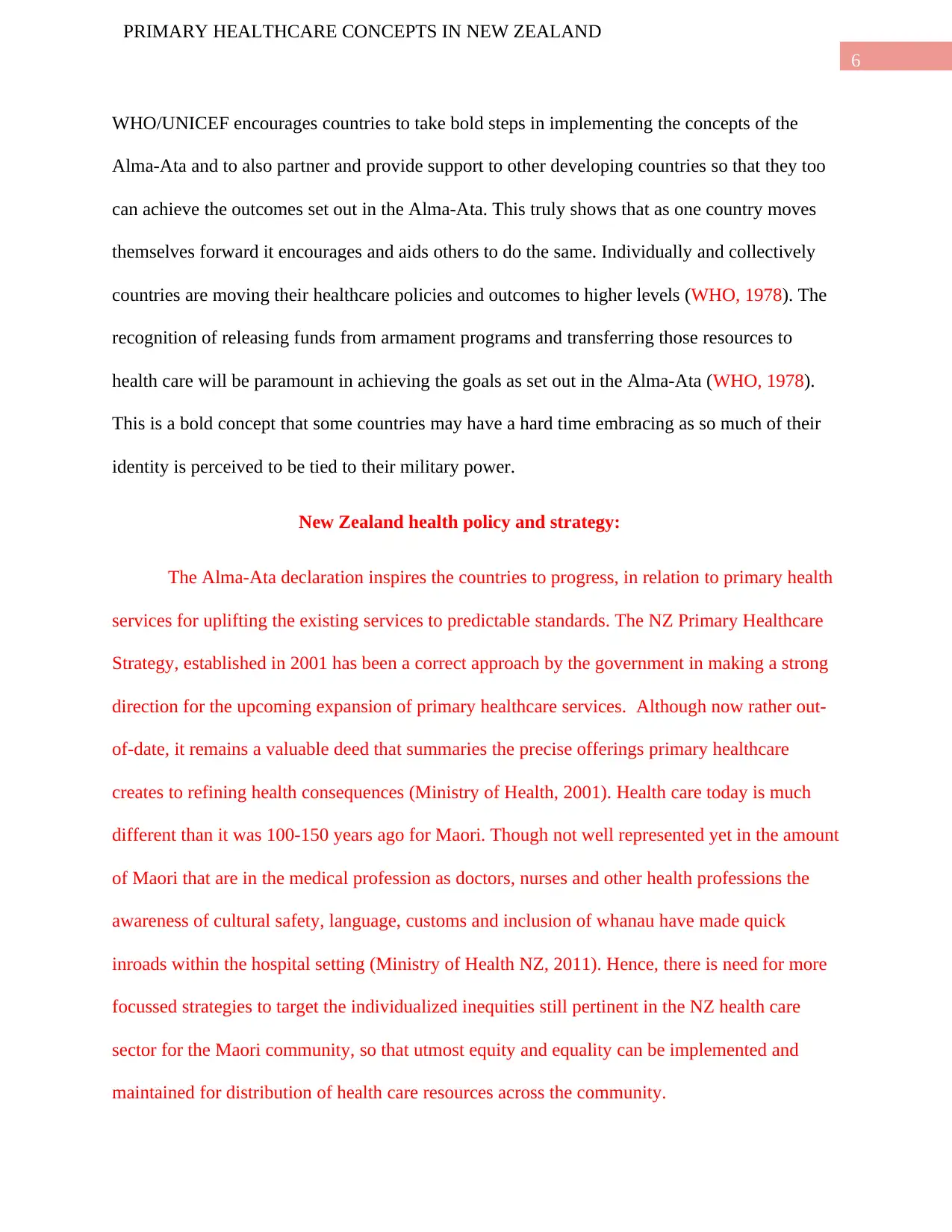
6
PRIMARY HEALTHCARE CONCEPTS IN NEW ZEALAND
WHO/UNICEF encourages countries to take bold steps in implementing the concepts of the
Alma-Ata and to also partner and provide support to other developing countries so that they too
can achieve the outcomes set out in the Alma-Ata. This truly shows that as one country moves
themselves forward it encourages and aids others to do the same. Individually and collectively
countries are moving their healthcare policies and outcomes to higher levels (WHO, 1978). The
recognition of releasing funds from armament programs and transferring those resources to
health care will be paramount in achieving the goals as set out in the Alma-Ata (WHO, 1978).
This is a bold concept that some countries may have a hard time embracing as so much of their
identity is perceived to be tied to their military power.
New Zealand health policy and strategy:
The Alma-Ata declaration inspires the countries to progress, in relation to primary health
services for uplifting the existing services to predictable standards. The NZ Primary Healthcare
Strategy, established in 2001 has been a correct approach by the government in making a strong
direction for the upcoming expansion of primary healthcare services. Although now rather out-
of-date, it remains a valuable deed that summaries the precise offerings primary healthcare
creates to refining health consequences (Ministry of Health, 2001). Health care today is much
different than it was 100-150 years ago for Maori. Though not well represented yet in the amount
of Maori that are in the medical profession as doctors, nurses and other health professions the
awareness of cultural safety, language, customs and inclusion of whanau have made quick
inroads within the hospital setting (Ministry of Health NZ, 2011). Hence, there is need for more
focussed strategies to target the individualized inequities still pertinent in the NZ health care
sector for the Maori community, so that utmost equity and equality can be implemented and
maintained for distribution of health care resources across the community.
PRIMARY HEALTHCARE CONCEPTS IN NEW ZEALAND
WHO/UNICEF encourages countries to take bold steps in implementing the concepts of the
Alma-Ata and to also partner and provide support to other developing countries so that they too
can achieve the outcomes set out in the Alma-Ata. This truly shows that as one country moves
themselves forward it encourages and aids others to do the same. Individually and collectively
countries are moving their healthcare policies and outcomes to higher levels (WHO, 1978). The
recognition of releasing funds from armament programs and transferring those resources to
health care will be paramount in achieving the goals as set out in the Alma-Ata (WHO, 1978).
This is a bold concept that some countries may have a hard time embracing as so much of their
identity is perceived to be tied to their military power.
New Zealand health policy and strategy:
The Alma-Ata declaration inspires the countries to progress, in relation to primary health
services for uplifting the existing services to predictable standards. The NZ Primary Healthcare
Strategy, established in 2001 has been a correct approach by the government in making a strong
direction for the upcoming expansion of primary healthcare services. Although now rather out-
of-date, it remains a valuable deed that summaries the precise offerings primary healthcare
creates to refining health consequences (Ministry of Health, 2001). Health care today is much
different than it was 100-150 years ago for Maori. Though not well represented yet in the amount
of Maori that are in the medical profession as doctors, nurses and other health professions the
awareness of cultural safety, language, customs and inclusion of whanau have made quick
inroads within the hospital setting (Ministry of Health NZ, 2011). Hence, there is need for more
focussed strategies to target the individualized inequities still pertinent in the NZ health care
sector for the Maori community, so that utmost equity and equality can be implemented and
maintained for distribution of health care resources across the community.
Paraphrase This Document
Need a fresh take? Get an instant paraphrase of this document with our AI Paraphraser

7
PRIMARY HEALTHCARE CONCEPTS IN NEW ZEALAND
Conclusion
To conclude, access to complete, superior healthcare facilities is significant for
promoting and upholding health, averting and handling disease, plummeting needless disability
and untimely death, and accomplishing health equity for all people. It is through the complete
contribution of primary healthcare centres and at an expense that the nation and the community
can have enough money to preserve at every phase of their growth in the soul of self-
determination and self-reliance. Likewise, societies from remote areas in New Zealand
experience also encounter situations that involves huge travel time to reach the medical centres,
hospital or clinics, with the aim of obtaining treatment for health ailments. The Declaration of
Alma-Ata articulated the necessity for crucial action by all administrations, all well-being and
development workforces, to defend and uphold health of all people. Thus, it can be concluded
that the NZ government has already taken much efforts in relation to the three components of
primary healthcare. Nonetheless, much work is left to be done to increase accessibility,
community participation, and eliminate inequity.
PRIMARY HEALTHCARE CONCEPTS IN NEW ZEALAND
Conclusion
To conclude, access to complete, superior healthcare facilities is significant for
promoting and upholding health, averting and handling disease, plummeting needless disability
and untimely death, and accomplishing health equity for all people. It is through the complete
contribution of primary healthcare centres and at an expense that the nation and the community
can have enough money to preserve at every phase of their growth in the soul of self-
determination and self-reliance. Likewise, societies from remote areas in New Zealand
experience also encounter situations that involves huge travel time to reach the medical centres,
hospital or clinics, with the aim of obtaining treatment for health ailments. The Declaration of
Alma-Ata articulated the necessity for crucial action by all administrations, all well-being and
development workforces, to defend and uphold health of all people. Thus, it can be concluded
that the NZ government has already taken much efforts in relation to the three components of
primary healthcare. Nonetheless, much work is left to be done to increase accessibility,
community participation, and eliminate inequity.
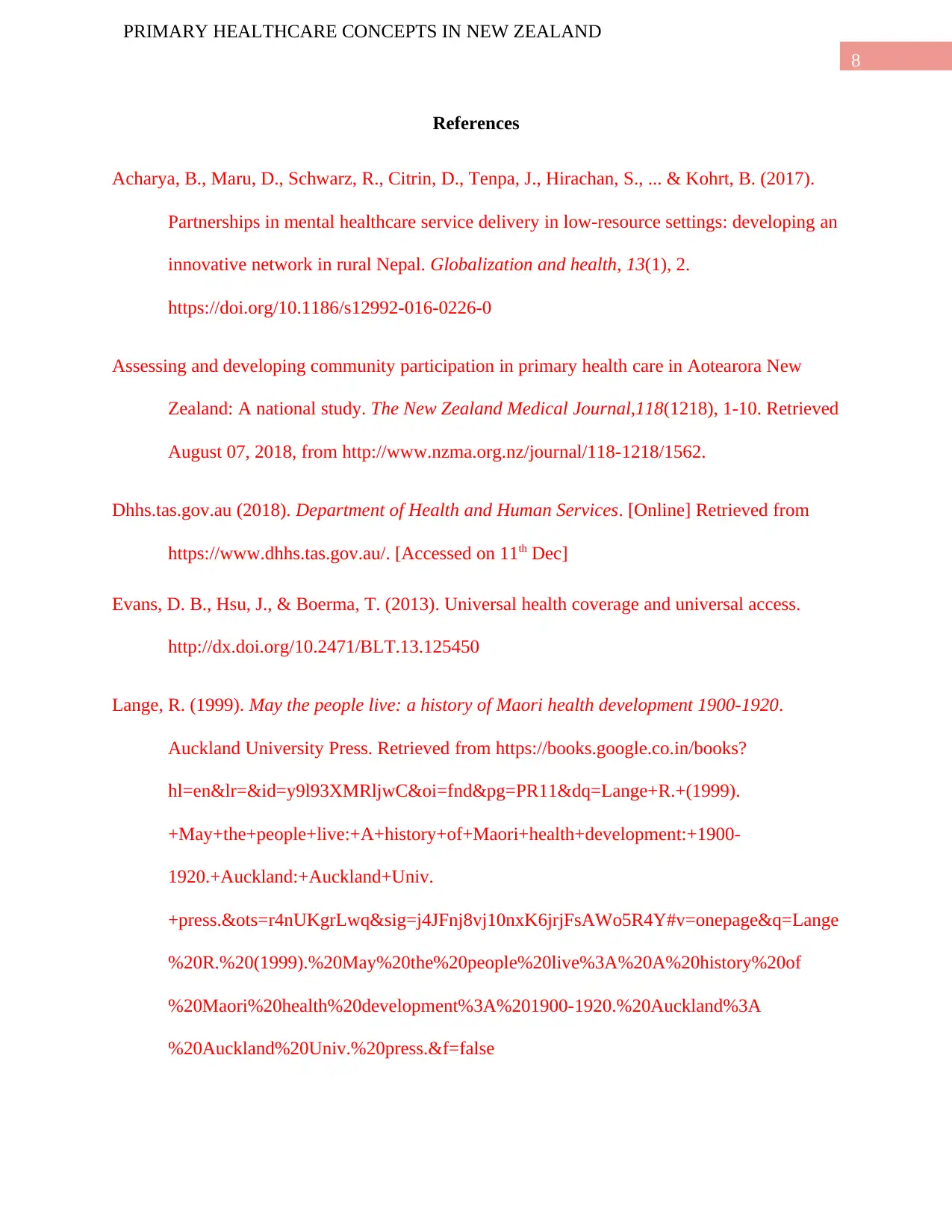
8
PRIMARY HEALTHCARE CONCEPTS IN NEW ZEALAND
References
Acharya, B., Maru, D., Schwarz, R., Citrin, D., Tenpa, J., Hirachan, S., ... & Kohrt, B. (2017).
Partnerships in mental healthcare service delivery in low-resource settings: developing an
innovative network in rural Nepal. Globalization and health, 13(1), 2.
https://doi.org/10.1186/s12992-016-0226-0
Assessing and developing community participation in primary health care in Aotearora New
Zealand: A national study. The New Zealand Medical Journal,118(1218), 1-10. Retrieved
August 07, 2018, from http://www.nzma.org.nz/journal/118-1218/1562.
Dhhs.tas.gov.au (2018). Department of Health and Human Services. [Online] Retrieved from
https://www.dhhs.tas.gov.au/. [Accessed on 11th Dec]
Evans, D. B., Hsu, J., & Boerma, T. (2013). Universal health coverage and universal access.
http://dx.doi.org/10.2471/BLT.13.125450
Lange, R. (1999). May the people live: a history of Maori health development 1900-1920.
Auckland University Press. Retrieved from https://books.google.co.in/books?
hl=en&lr=&id=y9l93XMRljwC&oi=fnd&pg=PR11&dq=Lange+R.+(1999).
+May+the+people+live:+A+history+of+Maori+health+development:+1900-
1920.+Auckland:+Auckland+Univ.
+press.&ots=r4nUKgrLwq&sig=j4JFnj8vj10nxK6jrjFsAWo5R4Y#v=onepage&q=Lange
%20R.%20(1999).%20May%20the%20people%20live%3A%20A%20history%20of
%20Maori%20health%20development%3A%201900-1920.%20Auckland%3A
%20Auckland%20Univ.%20press.&f=false
PRIMARY HEALTHCARE CONCEPTS IN NEW ZEALAND
References
Acharya, B., Maru, D., Schwarz, R., Citrin, D., Tenpa, J., Hirachan, S., ... & Kohrt, B. (2017).
Partnerships in mental healthcare service delivery in low-resource settings: developing an
innovative network in rural Nepal. Globalization and health, 13(1), 2.
https://doi.org/10.1186/s12992-016-0226-0
Assessing and developing community participation in primary health care in Aotearora New
Zealand: A national study. The New Zealand Medical Journal,118(1218), 1-10. Retrieved
August 07, 2018, from http://www.nzma.org.nz/journal/118-1218/1562.
Dhhs.tas.gov.au (2018). Department of Health and Human Services. [Online] Retrieved from
https://www.dhhs.tas.gov.au/. [Accessed on 11th Dec]
Evans, D. B., Hsu, J., & Boerma, T. (2013). Universal health coverage and universal access.
http://dx.doi.org/10.2471/BLT.13.125450
Lange, R. (1999). May the people live: a history of Maori health development 1900-1920.
Auckland University Press. Retrieved from https://books.google.co.in/books?
hl=en&lr=&id=y9l93XMRljwC&oi=fnd&pg=PR11&dq=Lange+R.+(1999).
+May+the+people+live:+A+history+of+Maori+health+development:+1900-
1920.+Auckland:+Auckland+Univ.
+press.&ots=r4nUKgrLwq&sig=j4JFnj8vj10nxK6jrjFsAWo5R4Y#v=onepage&q=Lange
%20R.%20(1999).%20May%20the%20people%20live%3A%20A%20history%20of
%20Maori%20health%20development%3A%201900-1920.%20Auckland%3A
%20Auckland%20Univ.%20press.&f=false
⊘ This is a preview!⊘
Do you want full access?
Subscribe today to unlock all pages.

Trusted by 1+ million students worldwide
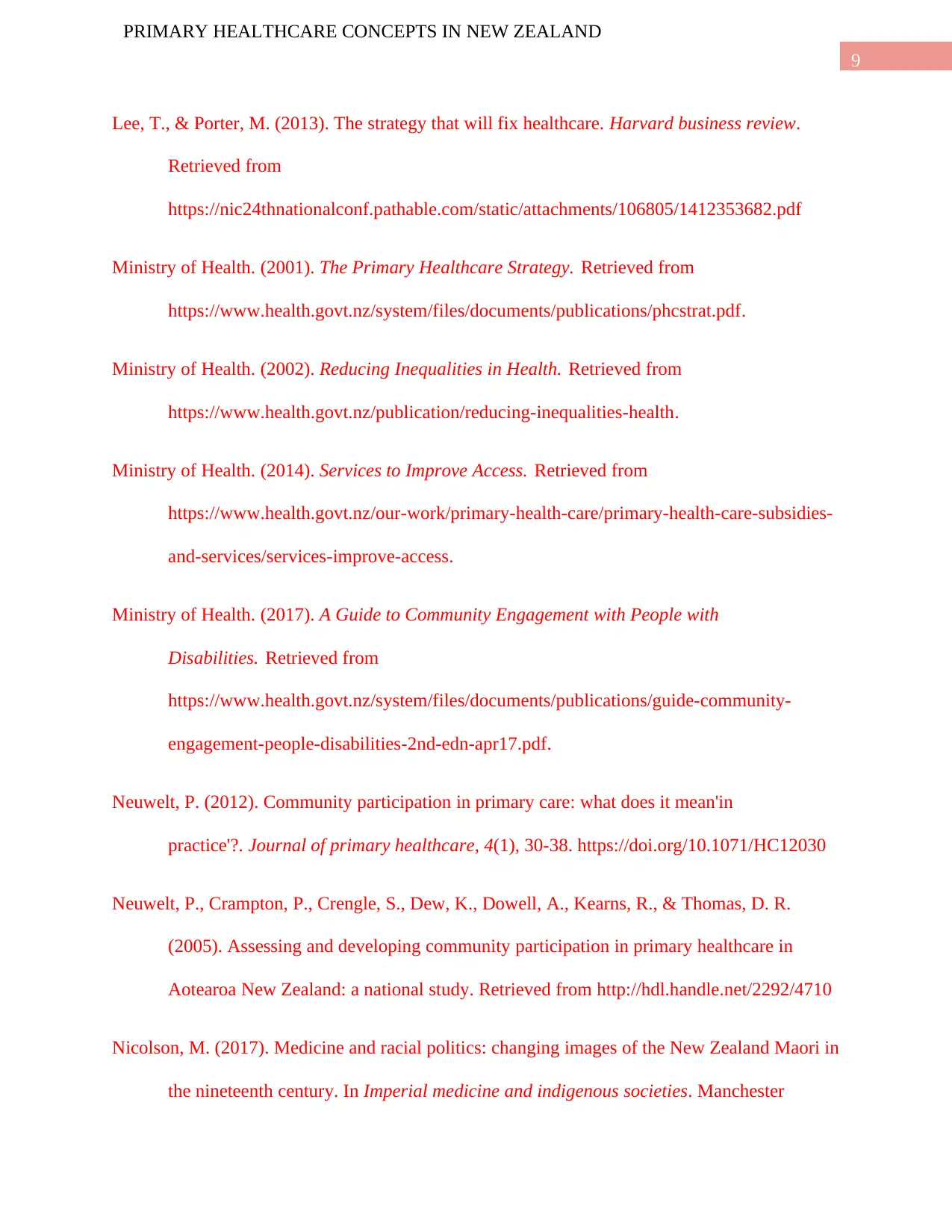
9
PRIMARY HEALTHCARE CONCEPTS IN NEW ZEALAND
Lee, T., & Porter, M. (2013). The strategy that will fix healthcare. Harvard business review.
Retrieved from
https://nic24thnationalconf.pathable.com/static/attachments/106805/1412353682.pdf
Ministry of Health. (2001). The Primary Healthcare Strategy. Retrieved from
https://www.health.govt.nz/system/files/documents/publications/phcstrat.pdf.
Ministry of Health. (2002). Reducing Inequalities in Health. Retrieved from
https://www.health.govt.nz/publication/reducing-inequalities-health.
Ministry of Health. (2014). Services to Improve Access. Retrieved from
https://www.health.govt.nz/our-work/primary-health-care/primary-health-care-subsidies-
and-services/services-improve-access.
Ministry of Health. (2017). A Guide to Community Engagement with People with
Disabilities. Retrieved from
https://www.health.govt.nz/system/files/documents/publications/guide-community-
engagement-people-disabilities-2nd-edn-apr17.pdf.
Neuwelt, P. (2012). Community participation in primary care: what does it mean'in
practice'?. Journal of primary healthcare, 4(1), 30-38. https://doi.org/10.1071/HC12030
Neuwelt, P., Crampton, P., Crengle, S., Dew, K., Dowell, A., Kearns, R., & Thomas, D. R.
(2005). Assessing and developing community participation in primary healthcare in
Aotearoa New Zealand: a national study. Retrieved from http://hdl.handle.net/2292/4710
Nicolson, M. (2017). Medicine and racial politics: changing images of the New Zealand Maori in
the nineteenth century. In Imperial medicine and indigenous societies. Manchester
PRIMARY HEALTHCARE CONCEPTS IN NEW ZEALAND
Lee, T., & Porter, M. (2013). The strategy that will fix healthcare. Harvard business review.
Retrieved from
https://nic24thnationalconf.pathable.com/static/attachments/106805/1412353682.pdf
Ministry of Health. (2001). The Primary Healthcare Strategy. Retrieved from
https://www.health.govt.nz/system/files/documents/publications/phcstrat.pdf.
Ministry of Health. (2002). Reducing Inequalities in Health. Retrieved from
https://www.health.govt.nz/publication/reducing-inequalities-health.
Ministry of Health. (2014). Services to Improve Access. Retrieved from
https://www.health.govt.nz/our-work/primary-health-care/primary-health-care-subsidies-
and-services/services-improve-access.
Ministry of Health. (2017). A Guide to Community Engagement with People with
Disabilities. Retrieved from
https://www.health.govt.nz/system/files/documents/publications/guide-community-
engagement-people-disabilities-2nd-edn-apr17.pdf.
Neuwelt, P. (2012). Community participation in primary care: what does it mean'in
practice'?. Journal of primary healthcare, 4(1), 30-38. https://doi.org/10.1071/HC12030
Neuwelt, P., Crampton, P., Crengle, S., Dew, K., Dowell, A., Kearns, R., & Thomas, D. R.
(2005). Assessing and developing community participation in primary healthcare in
Aotearoa New Zealand: a national study. Retrieved from http://hdl.handle.net/2292/4710
Nicolson, M. (2017). Medicine and racial politics: changing images of the New Zealand Maori in
the nineteenth century. In Imperial medicine and indigenous societies. Manchester
Paraphrase This Document
Need a fresh take? Get an instant paraphrase of this document with our AI Paraphraser
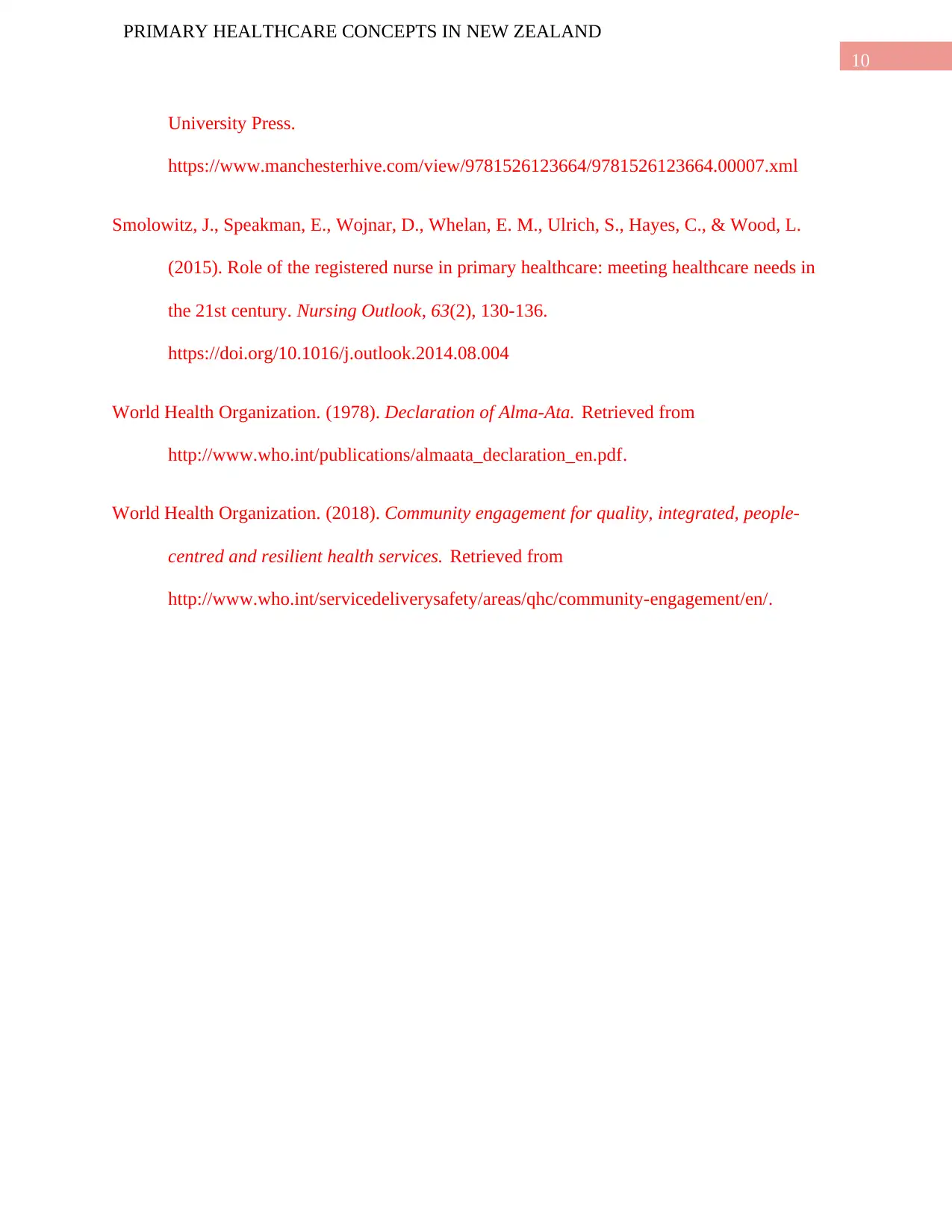
10
PRIMARY HEALTHCARE CONCEPTS IN NEW ZEALAND
University Press.
https://www.manchesterhive.com/view/9781526123664/9781526123664.00007.xml
Smolowitz, J., Speakman, E., Wojnar, D., Whelan, E. M., Ulrich, S., Hayes, C., & Wood, L.
(2015). Role of the registered nurse in primary healthcare: meeting healthcare needs in
the 21st century. Nursing Outlook, 63(2), 130-136.
https://doi.org/10.1016/j.outlook.2014.08.004
World Health Organization. (1978). Declaration of Alma-Ata. Retrieved from
http://www.who.int/publications/almaata_declaration_en.pdf.
World Health Organization. (2018). Community engagement for quality, integrated, people-
centred and resilient health services. Retrieved from
http://www.who.int/servicedeliverysafety/areas/qhc/community-engagement/en/.
PRIMARY HEALTHCARE CONCEPTS IN NEW ZEALAND
University Press.
https://www.manchesterhive.com/view/9781526123664/9781526123664.00007.xml
Smolowitz, J., Speakman, E., Wojnar, D., Whelan, E. M., Ulrich, S., Hayes, C., & Wood, L.
(2015). Role of the registered nurse in primary healthcare: meeting healthcare needs in
the 21st century. Nursing Outlook, 63(2), 130-136.
https://doi.org/10.1016/j.outlook.2014.08.004
World Health Organization. (1978). Declaration of Alma-Ata. Retrieved from
http://www.who.int/publications/almaata_declaration_en.pdf.
World Health Organization. (2018). Community engagement for quality, integrated, people-
centred and resilient health services. Retrieved from
http://www.who.int/servicedeliverysafety/areas/qhc/community-engagement/en/.
1 out of 11
Related Documents
Your All-in-One AI-Powered Toolkit for Academic Success.
+13062052269
info@desklib.com
Available 24*7 on WhatsApp / Email
![[object Object]](/_next/static/media/star-bottom.7253800d.svg)
Unlock your academic potential
Copyright © 2020–2025 A2Z Services. All Rights Reserved. Developed and managed by ZUCOL.





